What Is GPS and how do global positioning systems work?
GPS (Global Positioning System) is a satellite-based navigation system that provides real-time location, speed and time data, essential for tracking, routing and optimizing fleet operations.
By Geotab Team
Jul 7, 2025
Updated: Jul 8, 2025
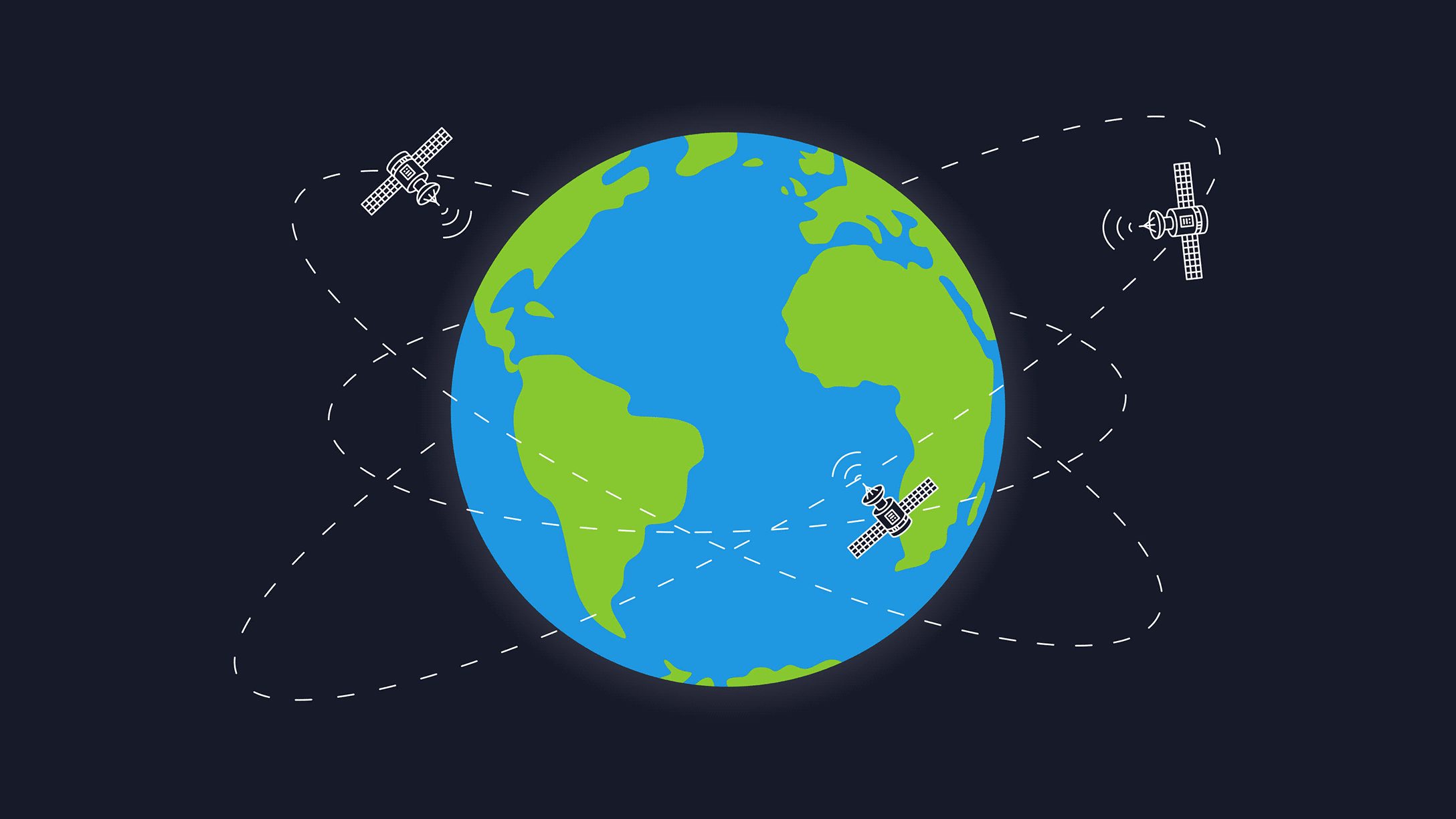
Key Insights
- GPS, or Global Positioning System, is a network of satellites that transmit signals to GPS receivers, allowing them to determine precise geographic location and movement.
- Fleet managers use GPS to track vehicles in real time, optimize routes, monitor driver behavior and improve overall operational efficiency.
- GPS technology helps fleets reduce fuel costs, improve delivery times, enhance safety and increase customer satisfaction through better visibility and control.
GPS is everywhere — you’ll find it in your car, your smartphone, even your watch. It helps you get from point A to point B without a second thought.
For fleets, GPS is much more than navigation; it’s a critical tool for real-time vehicle tracking, route optimization and operational efficiency. Whether a driver needs to avoid sudden traffic or a fleet manager wants to monitor idle time, GPS streamlines decision-making and keeps everything running smoothly.
In this article, we’ll explore how GPS works behind the scenes, how fleets use it daily and where the technology is headed next.
What is GPS and how does it work?
The Global Positioning System (GPS) is a navigation system using satellites, a receiver and algorithms to synchronize location, velocity and time data for air, sea and land travel.
The satellite system consists of a constellation of at least 31 satellites in six Earth-centered orbital planes, each with four satellites, orbiting at 13,000 miles (20,000 km) above Earth and traveling at a speed of 8,700 mph (14,000 km/h).
While we only need three satellites to produce a location on Earth’s surface, a fourth satellite is often used to correct the receiver’s clock error, which allows for more accurate positioning. The fourth satellite also enables us to calculate the altitude of a device, moving us into the third dimension.
What are the 3 elements of GPS?
GPS is made up of three different components, called segments, that work together to provide location information.
The three segments of GPS are:
- Space (satellites): The satellites circle the Earth, transmitting signals to users on geographical position and time of day. For fleets, these satellites enable real-time vehicle tracking and accurate route navigation, even in remote areas without cell service.
- Ground control: The Control Segment is made up of Earth-based monitor stations, master control stations and ground antenna. Control activities include tracking and operating the satellites in space and monitoring transmissions. There are monitoring stations on almost every continent in the world, including North and South America, Africa, Europe, Asia and Australia.
- User equipment: Including GPS receivers and transmitters, including items like watches, smartphones and telematic devices. In fleet operations, devices like telematics units or driver smartphones receive satellite signals and calculate exact positions to support dispatching and fleet safety.
How does GPS technology work?
GPS works through a technique called trilateration. Used to calculate location, velocity and elevation, trilateration collects signals from satellites to output location information.
Note: Trilateration is often mistaken for triangulation, which is used to measure angles, not distances.
Here’s how it works:
- Satellites orbiting the Earth send signals to be read and interpreted by a GPS device, situated on or near the Earth’s surface. To calculate location, a GPS device must be able to read the signal from at least four satellites.
- Each satellite in the network circles the Earth twice a day, and sends a unique signal, orbital parameters and time. At any given moment, a GPS device can read the signals from six or more satellites.
- A single satellite broadcasts a microwave signal, which is picked up by a GPS device and used to calculate the distance from the GPS device to the satellite. Since a GPS device only gives information about the distance from a satellite, a single satellite cannot provide much location information.
Satellites do not give off information about angles, so the location of a GPS device could be anywhere on a sphere’s surface area. - When a satellite sends a signal, it creates a circle with a radius measured from the GPS device to the satellite.
- After adding a second satellite, it creates a second circle, and the location is narrowed down to one of two points where the circles intersect.
With a third satellite, the device’s location can finally be determined, as the device is at the intersection of all three circles.
That said, we live in a three-dimensional world, which means that each satellite produces a sphere, not a circle. The intersection of three spheres produces two points of intersection, so the point nearest Earth is chosen.
Here is an illustration of satellite ranging
![Ranging]()
- As GPS devices move, the radius (distance to the satellite) changes. When the radius changes, new spheres are produced, giving us a new position. We can use that data, combined with the time from the satellite, to determine velocity, calculate the distance to our destination and the ETA.
What are the uses of GPS?
GPS is a powerful and dependable tool for businesses and organizations in many different industries. Surveyors, fleet drivers, scientists, pilots, boat captains, first responders and workers in mining and agriculture are just some of the people who use GPS on a daily basis for work.
They use GPS information for preparing accurate surveys and maps, taking precise time measurements, tracking position or location and for navigation. GPS works at all times and in almost all weather conditions.
There are five main uses of GPS:
- Location: Determining a position
- Navigation: Getting from one location to another
- Tracking: Monitoring objects or personal movement
- Mapping: Creating maps of the world
- Timing: Making it possible to take precise time measurements
GPS is especially valuable in fleet management, helping track vehicles in real time, optimize routes and improve driver safety and efficiency.
Keep reading for common use cases of GPS.
Emergency Response
During an emergency or natural disaster, first responders like police use GPS for mapping, following and predicting weather and keeping track of emergency personnel. In the EU and Russia, the eCall regulation relies on GLONASS technology (a GPS alternative) and telematics to send data to emergency services in the case of a vehicle crash, reducing response time. Read more about GPS tracking for first responders.
Entertainment
GPS can be incorporated into games and activities like Pokémon Go and geocaching.
Health and fitness:
Smartwatches and wearable technology can track fitness activity (such as running distance) and benchmark it against a similar demographic.
Construction, mining and off-road trucking
From locating equipment to measuring and improving fleet asset allocation, GPS enables companies in construction and mining to increase the return on their assets.
GPS technology enhances construction vehicle tracking by delivering real-time visibility into equipment usage and location, reducing downtime and improving asset allocation. It also supports off-road equipment tracking, enabling better fuel management, theft prevention, and operational efficiency in rugged environments.
Transportation
Many logistics companies implement telematics systems to improve driver productivity and safety. GPS trackers can be used to support fleet route optimization, fuel efficiency and fleet compliance.
Fleet managers also use GPS for advanced safety monitoring, such as curve logging, which captures detailed vehicle movement data to identify unsafe driving behaviors like harsh turns and abrupt stops.
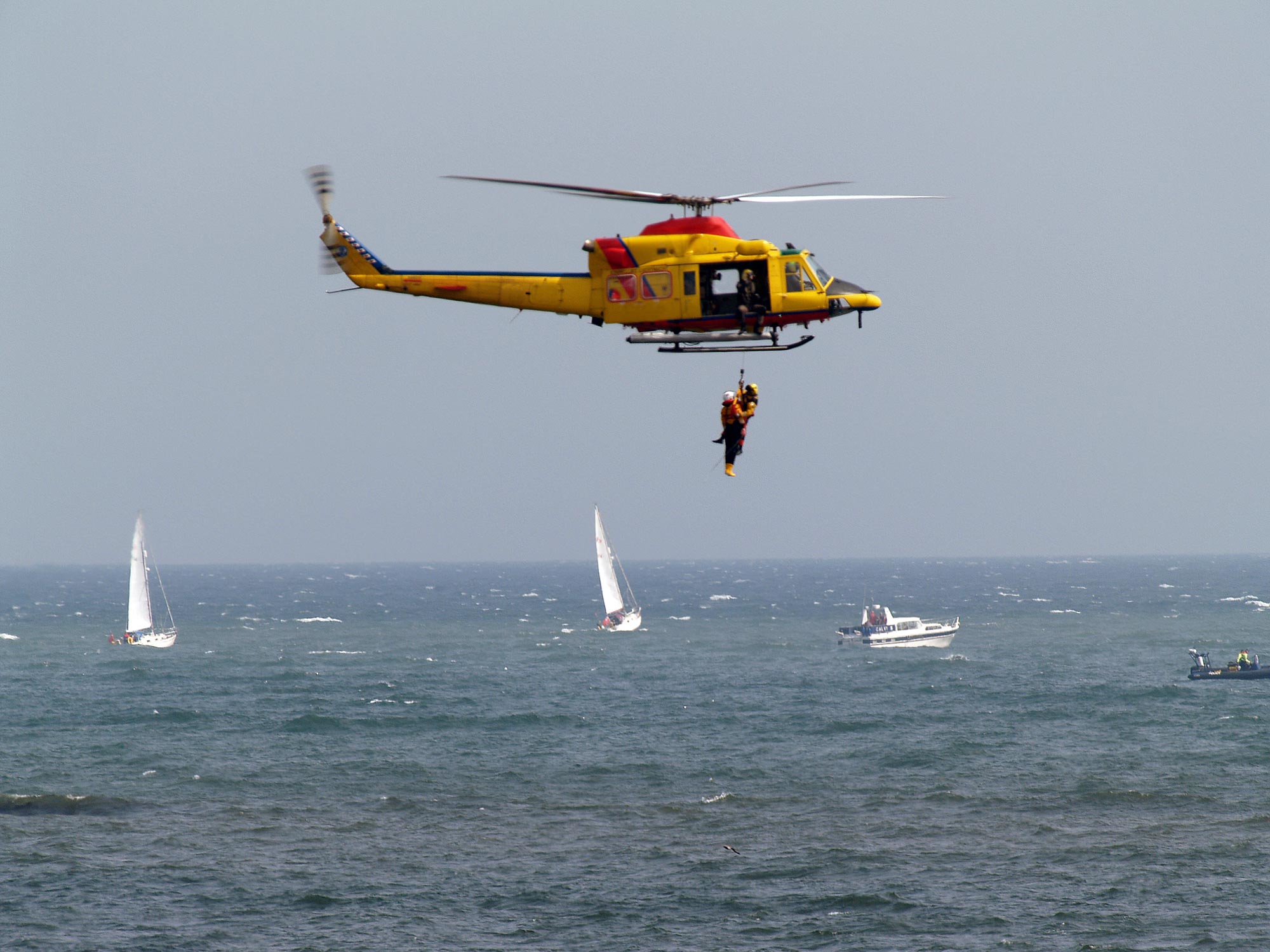
Other industries where GPS is used include: agriculture, autonomous vehicles, sales and services, the military, mobile communications, security, and fishing.
How accurate is GPS?
GPS device accuracy depends on many variables, such as the number of satellites available, the ionosphere, the urban environment and more.
Some factors that can hinder GPS accuracy include:
- Physical obstructions: Arrival time measurements can be skewed by large masses like mountains, buildings, trees and more.
- Atmospheric effects: Ionospheric delays, heavy storm cover and solar storms can all affect GPS devices.
- Ephemeris: The orbital model within a satellite could be incorrect or out-of-date, although this is becoming increasingly rare.
- Numerical miscalculations: This might be a factor when the device hardware is not designed to specifications.
- Artificial interference: These include GPS jamming devices or spoofs.
Accuracy tends to be higher in open areas with no adjacent tall buildings that can block signals. This effect is known as an urban canyon.
When a device is surrounded by large buildings, like in downtown Manhattan or Toronto, the satellite signal is first blocked, and then bounced off a building, where it is finally read by the device. This can result in miscalculations of the satellite distance.
In addition to physical and environmental factors, digital security is an important consideration for GPS safety. Protecting GPS tracking devices against cyberthreats like spoofing and jamming helps maintain reliable data. This can be done using encrypted signals, firmware updates, and backup location sources to ensure reliable data.
A brief history of GPS
The history of GPS begins with ancient navigation methods. Humans have been practicing navigation for thousands of years using the sun, moon, stars and later, the sextant. GPS was an advancement of the 20th century made possible by space-age technology.
GPS technology has been used globally throughout history. The launch of Russia’s Sputnik I satellite in 1957 ushered in the possibility of geolocation capabilities, and soon after, the U.S. Department of Defense began using it for submarine navigation.
In 1983, the U.S. government made GPS publicly available but still kept control of the available data. It wasn’t until 2000 that companies and the general public gained full access to the use of GPS, eventually paving the way for greater GPS advancement.
Global Navigation Satellite Systems (GNSS)
A GPS is considered a Global Navigation Satellite System — meaning it’s a satellite navigation system with global coverage.
As of 2020, there are three fully operational global navigation satellite systems:
- The U.S. navigation signal timing and ranging (NAVSTAR) GPS
- Russia’s Global Navigation Satellite System (GLONASS)
- Europe’s Galileo system
The NAVSTAR GPS consists of 32 satellites owned by the U.S. and is the best-known and most widely utilized satellite system. Russia’s GLONASS consists of 24 operational satellites with three remaining as spares or in testing.
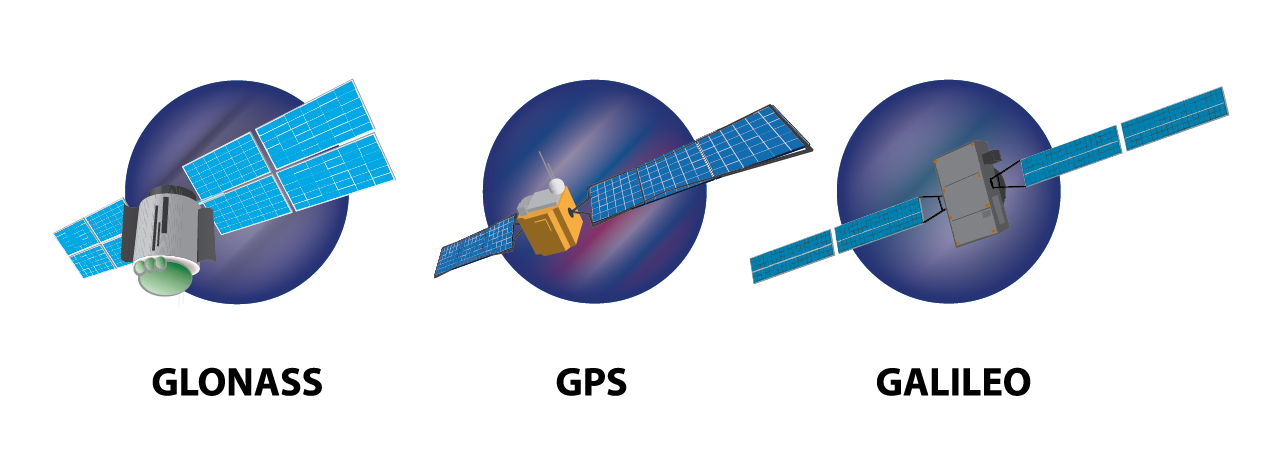
Illustration of GLONASS, GPS and Galileo Satellites.
Other countries are also racing to catch up. The EU, for example, has been working on Galileo since 1999, which reached full operational capacity at the end of 2020.
China built the BeiDou Navigation Satellite System, reaching 35 satellites in orbit by June 2020. Japan and India have developed their own operational regional systems, the Quasi-Zenith Satellite System (QZSS) and the Indian Regional Navigation Satellite System (IRNSS), respectively.
GPS devices vs. GNSS devices
Though GPS is a subset of GNSS, receivers are differentiated as GPS (meaning GPS only) or GNSS. A GPS receiver is only capable of reading information from satellites in the GPS satellite network, while the typical GNSS device can receive information from both GPS and GLONASS (or more than these two systems) at a time.
| Feature | GPS | GNSS |
|---|---|---|
| Full name | Global Positioning System | Global Navigation Satellite System |
| Type | Single satellite system | All global satellite systems (umbrella term) |
| Operated by | U.S. government | U.S., Russia, EU, China, etc. |
| Examples | GPS (U.S.) | GPS, GLONASS, Galileo, BeiDou |
| Coverage | Global | Global |
| Accuracy | ~16-33 feet | ~3-10 feet (with multi-system receivers) |
| Reliability | High, but depends on one system | Higher (multiple systems for redundancy) |
What are GNSS devices?
GNSS devices are electronic devices that use signals from a network of satellites to determine the location, speed and direction of a person or object.
A GNSS receiver has 60 satellites available for viewing. While a device only needs three satellites to determine its location, accuracy is improved with a larger number of satellites.
The chart below shows an example of the number of satellites available (shown in green), along with their signal strength (height of the column) to a GPS receiver. In this case, 12 satellites are available.
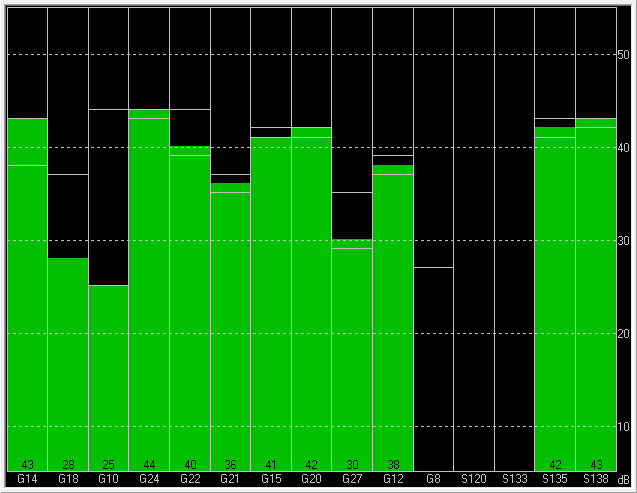
Typical GPS-only test board showing 12 satellite signals (green), using U-Center software.
A GNSS device can see more satellites, which helps improve device accuracy. In the chart below, there are 17 available satellites. Green bars are part of GPS, and blue bars are part of GLONASS.
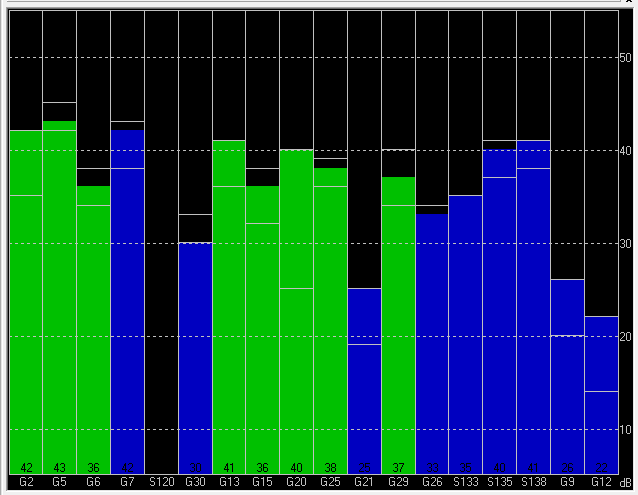
Typical GNSS test board showing 17 satellite signals (GPS = green; GLONASS = blue), using U-Center software.
A larger number of satellites providing information to a receiver enables the GPS device to calculate location with greater precision. More satellites give a device a better chance of getting a positional fix when the receiver has calculated the location of the user.
That said, GNSS receivers have some drawbacks:
- GNSS chips cost more than GPS devices.
- GNSS uses a wider bandwidth (1559-1610 MHz) than GPS (1559-1591 MHz). This means standard GPS radio frequency components, such as antennas, filters and amplifiers, cannot be used for GNSS receivers, resulting in higher costs.
- Power consumption is slightly higher than with GPS receivers, as it connects to more satellites and runs the calculations to determine location.
The future of GPS
Countries continue to build and make improvements to their GPS systems. Efforts worldwide are being made to increase accuracy and improve reliability and GPS capabilities.
For example:
- GNSS receivers are expected to become smaller, more accurate and more efficient, and GNSS technology is set to penetrate even the most cost-sensitive GPS applications.
- Scientists and rescue workers are finding new ways to use GPS technology in natural disaster prevention and analysis in the event of an earthquake, volcanic eruption, sinkhole or avalanche.
- For the COVID-19 pandemic, researchers used cellphone location data to assist with contact tracing in order to slow down the spread of the virus.
- The launch of new GPS III satellites in 2023 refined GPS accuracy to 3-10 feet, improved navigation abilities, and introduced longer-lasting components. They also broadcasting on the L1C civilian signal for interoperability with other satellite systems.
- The next generation of GPS satellites will include better signal protection, decreased susceptibility to signal jamming and more maneuverability to cover dead zones.
- The National Aeronautics and Space Administration’s (NASA) Deep Space Atomic Clock is set to use a powerful onboard GPS satellite to help provide better consistency in time for future astronauts embarking on deep space journeys.
The future of GPS tracking will likely be far more accurate and effective for both personal and business use.
Unlocking the power of GPS for fleets with Geotab
GPS has become a cornerstone of modern fleet operations, helping businesses track vehicles in real time, reduce fuel costs and improve driver safety. With the help of vehicle tracking devices, fleets can improve asset location and performance.
When combined with the best GPS tracking devices on the market, this data becomes even more powerful, assisting with smarter routing, faster response times and better decision-making across the board.
As GPS technology continues to evolve, it will remain essential to keeping fleets efficient, safe and competitive.
Subscribe to get industry tips and insights
Frequently Asked Questions
In fleets, GPS is used to track vehicle locations in real time, optimize routes, monitor driver behavior, improve fuel efficiency, ensure timely deliveries and enhance overall safety.
It helps fleet managers make data-driven decisions to reduce costs, increase productivity and maintain better control over their assets.
GPS spoofing and jamming are attacks that interfere with GPS signals. Spoofing sends fake signals to trick devices into showing incorrect locations, while GPS jammers block signals altogether, causing loss of GPS service.
Both can disrupt navigation and tracking, creating safety and security risks for fleets.
A GPS tracker is a device that uses signals from GPS satellites to determine and record the precise location of a person, vehicle or asset in real time. It sends this location data to a central system or app, allowing users to monitor movement, track routes and improve security and efficiency.
The Geotab Team write about company news.
Table of Contents
Subscribe to get industry tips and insights
Related posts
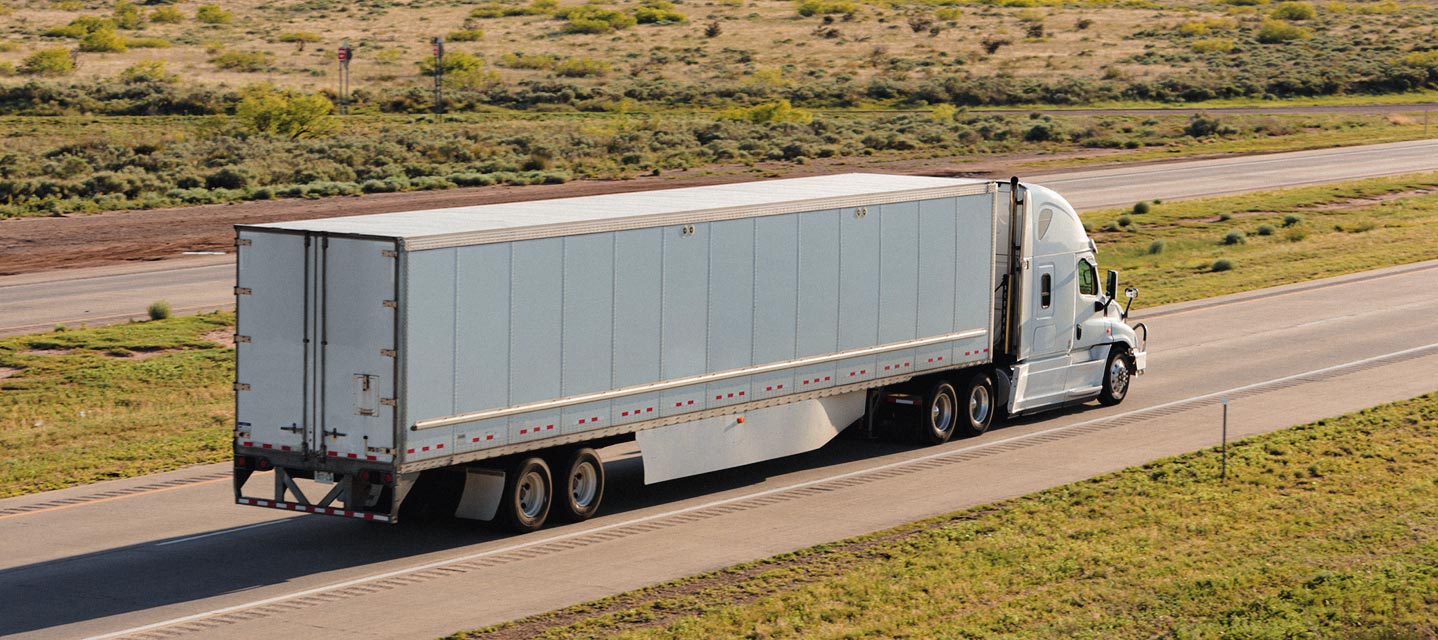
The future of transportation: Trends, research and what’s next according to experts
July 17, 2025
9 minute read
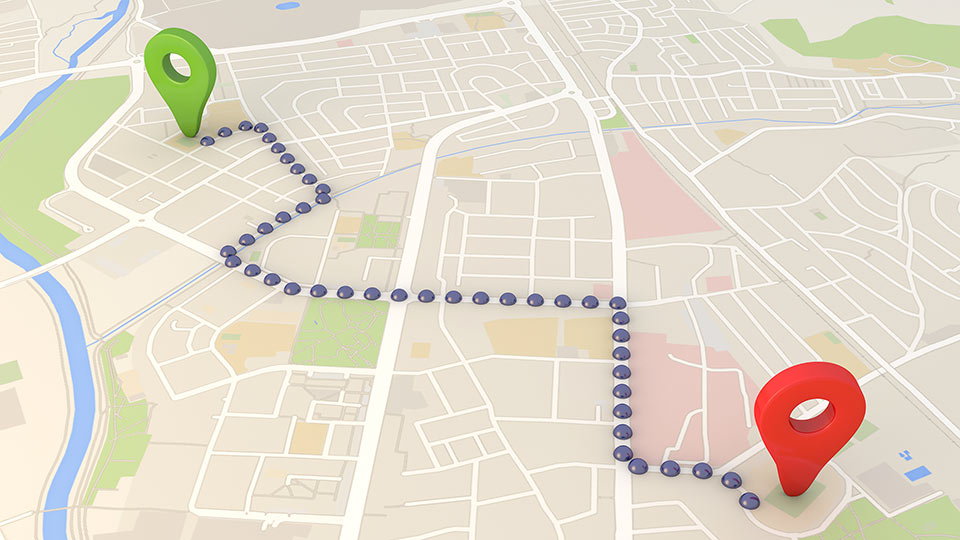

Smart selection guide for school bus fleet maintenance features
May 21, 2025
5 minute read

What is government fleet management software and how is it used?
April 10, 2025
3 minute read

Enhancing student bus safety: Combating distracted driving in the digital age
April 7, 2025
6 minute read
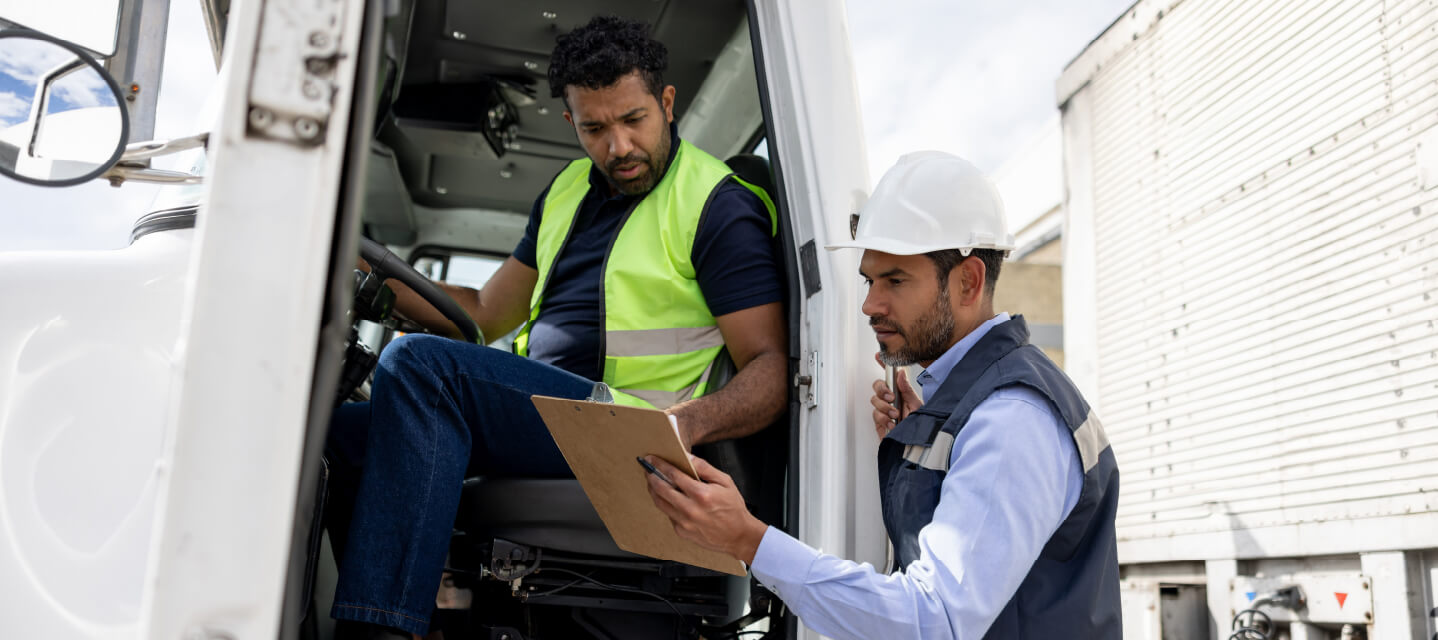
What Is Fleet Management? A Complete Guide for Fleet Managers
January 21, 2025
5 minute read
.png)